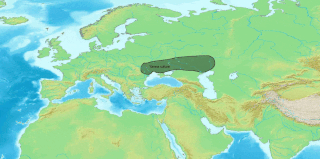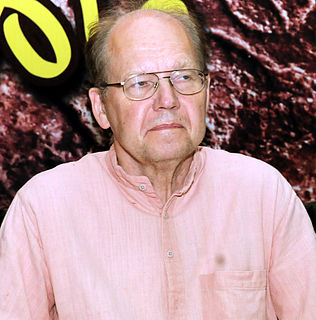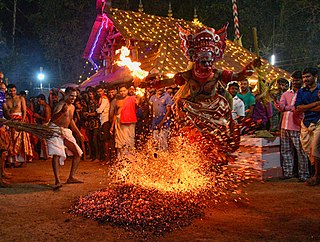This article may require cleanup to meet Wikipedia's quality standards. The specific problem is: The article is full of incorrect capitalization.(August 2019) (Learn how and when to remove this template message) |
| Dravidian | |||
|---|---|---|---|
| Geographic distribution | South Asia and parts of Southeast Asia, mainly South India and Sri Lanka | ||
| Linguistic classification | One of the world's primary language families | ||
| Proto-language | Proto-Dravidian | ||
| Subdivisions |
| ||
| ISO 639-2 / 5 | dra | ||
| Linguasphere | 49= (phylozone) | ||
| Glottolog | drav1251 [1] | ||
 Distribution of subgroups of Dravidian languages:
| |||
| Total population | |
|---|---|
| approx. 245 million | |
| Languages | |
| Dravidian languages | |
| Religion | |
| Predominantly Hinduism, Dravidian folk religion and others: Jainism, Buddhism, Islam, Christianity, Judaism |
| Part of a series on |
| Dravidian culture and history |
|---|
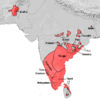 |
History
|
Regions
|
People |
| Portal:Dravidian civilizations |
Dravidian people or Dravidians are speakers of any of the Dravidian languages. There are around 245 million native speakers of Dravidian languages. [2] Dravidian speakers form the majority of the population of South India and are natively found in India, Pakistan, Afghanistan, [3] Bangladesh, the Maldives and Sri Lanka. [4]

The Dravidian languages are a language family spoken by more than 215 million people, mainly in Southern India and northern Sri Lanka, with pockets elsewhere in South Asia. Since the colonial era, there have been small but significant immigrant communities outside South Asia in countries such as Hong Kong, Malaysia, Singapore, Indonesia, Mauritius and the Philippines.

South India is the area including the five southern Indian states of Andhra Pradesh, Karnataka, Kerala, Tamil Nadu and Telangana, as well as the three union territories of Andaman and Nicobar islands, Lakshadweep and Puducherry, occupying 19% of India's area. Covering the southern part of the peninsular Deccan Plateau, South India is bounded by the Bay of Bengal in the east, the Arabian Sea in the west and the Indian Ocean in the south. The geography of the region is diverse with two mountain ranges–the Western and Eastern Ghats, bordering the plateau heartland. Godavari, Krishna, Kaveri, Tungabhadra, Periyar, Vaigai, Palar River ,Ponnaiyar,Thamiraparani rivers are important non-perennial sources of water. Bengaluru, Chennai, Hyderabad, Coimbatore, Kochi, Trivandrum, Visakhapatnam,Vellore, Tiruchirapalli, Madurai, Mysuru, Mangalore and Kozhikode are the largest urban areas.

India is a country in South Asia. It is the seventh-largest country by area, the second-most populous country, and the most populous democracy in the world. Bounded by the Indian Ocean on the south, the Arabian Sea on the southwest, and the Bay of Bengal on the southeast, it shares land borders with Pakistan to the west; China, Nepal, and Bhutan to the north; and Bangladesh and Myanmar to the east. In the Indian Ocean, India is in the vicinity of Sri Lanka and the Maldives; its Andaman and Nicobar Islands share a maritime border with Thailand and Indonesia.
Contents
- Etymology
- Ethnic groups
- Language
- History
- Origins
- Dravidian empires
- Medieval trade and influence
- Dravidian culture
- Religious belief
- Architecture and visual art
- Theatre, dance and music
- Costume
- Martial arts and sports
- See also
- Notes
- References
- Sources
- External links
Proto-Dravidian may have been spoken in the Indus civilization, suggesting a "tentative date of Proto-Dravidian around the early part of the third millennium", [5] after which it branched into various Dravidian languages. [6] South Dravidian I (including pre-Tamil) and South Dravidian II (including pre-Telugu) split around the eleventh century BCE, with the other major branches splitting off at around the same time. [7]
Proto-Dravidian is the linguistic reconstruction of the common ancestor of the Dravidian languages. It is thought to have differentiated into Proto-North Dravidian, Proto-Central Dravidian, and Proto-South Dravidian, although the date of diversification is still debated.

Tamil is a Dravidian language predominantly spoken by the Tamil people of India and Sri Lanka, and by the Tamil diaspora, Sri Lankan Moors, Douglas, and Chindians. Tamil is an official language in three countries: India, Sri Lanka and Singapore. In India, it is the official language of the Indian state of Tamil Nadu and the Union Territory of Puducherry. Furthermore, Tamil is used as one of the languages of education in Malaysia, along with English, Malay and Mandarin. Tamil is spoken by significant minorities in the four other South Indian states of Kerala, Karnataka, Andhra Pradesh and Telangana and the Union Territory of the Andaman and Nicobar Islands. It is one of the 22 scheduled languages of India.
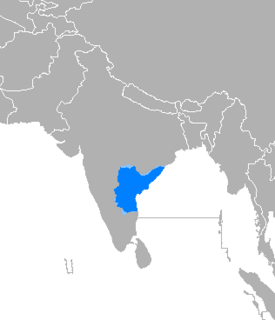
Telugu is a Dravidian language spoken in the Indian states of Andhra Pradesh, Telangana and the union territories of Puducherry (Yanam) by the Telugu people. It stands alongside Hindi, English and Bengali as one of the few languages with primary official language status in more than one Indian state. There are also significant linguistic minorities in neighbouring states. It is one of six languages designated a classical language of India by the country's government.
The origins of the Dravidians are a "very complex subject of research and debate". [8] They may have been indigenous to the Indian subcontinent, [9] [10] [11] but origins in, or influence from, West-Asia have also been proposed. [12] [13] [14] [15] [16] Their origins are often viewed as being connected with the Indus Valley Civilisation, [8] [16] [17] whence people and language spread east- and southwards after the demise of the Indus Valley Civilisation in the early second millenium BCE, [18] [19] concurrently with the arrival of Indo-Aryan speakers, [20] with whom they intensively interacted. [21] Some recent DNA evidence indicates a linkage between a corpse found in the Harappan site of Rakhigarhi in Haryana and "Ancestral South Indians". [22] From these interactions and migrations arose eventually the so-called "Hindus synthesis", after 500 BCE. [23]

The Indian subcontinent is a southern region and peninsula of Asia, mostly situated on the Indian Plate and projecting southwards into the Indian Ocean from the Himalayas. Geologically, the Indian subcontinent is related to the land mass that rifted from Gondwana and merged with the Eurasian plate nearly 55 million years ago. Geographically, it is the peninsular region in south-central Asia delineated by the Himalayas in the north, the Hindu Kush in the west, and the Arakanese in the east. Politically, the Indian subcontinent includes Bangladesh, Bhutan, India, Maldives, Nepal, Pakistan and Sri Lanka.

The Indus Valley Civilisation (IVC) was a Bronze Age civilisation in the northwestern regions of South Asia, lasting from 3300 BCE to 1300 BCE, and in its mature form from 2600 BCE to 1900 BCE. Along with ancient Egypt and Mesopotamia it was one of three early civilisations of the region comprising North Africa, West Asia and South Asia, and of the three, the most widespread, its sites spanning an area stretching from northeast Afghanistan, through much of Pakistan, and into western and northwestern India. It flourished in the basins of the Indus River, which flows through the length of Pakistan, and along a system of perennial, mostly monsoon-fed, rivers that once coursed in the vicinity of the seasonal Ghaggar-Hakra river in northwest India and eastern Pakistan.
The third century BCE onwards saw the development of large kingdoms in South India. Medieval Tamil guilds and trading organisations like the "Ayyavole and Manigramam" played an important role in the Southeast Asia trade. [24] and the cultural Indianisation of the region.

The Indian cultural sphere or Indosphere is an area that is composed of the many countries and regions in South and Southeast Asia that were historically influenced by Indian culture and the Sanskrit language. The term Greater India is used to encompass the historical and geographic extent of all political entities of the Indian subcontinent, and the regions which are culturally linked to India or received significant Sanskritization and Indian cultural influence. These countries have varying degrees been transformed by the acceptance and induction of cultural and institutional elements of India. Since around 500 BCE, Asia's expanding land and maritime trade had resulted in prolonged socio-economic and cultural stimulation and diffusion of Hindu and Buddhist beliefs into the region's cosmology, in particular in Southeast Asia and Sri Lanka. In Central Asia, transmission of ideas were predominantly of a religious nature.
Dravidian visual art is dominated by stylised temple architecture in major centres, and the production of images of stone and bronze sculptures. The sculpture dating from the Chola period has become notable as a symbol of Hinduism.

Dravidian architecture is an architectural idiom in Hindu temple architecture that emerged in the southern part of the Indian subcontinent or South India, reaching its final form by the sixteenth century. It consists primarily of Hindu temples where the dominating feature is the high gopura or gatehouse; large temples have several. Mentioned as one of three styles of temple building in the ancient book Vastu shastra, the majority of the existing structures are located in the Southern Indian states of Andhra Pradesh, Karnataka, Kerala, Tamil Nadu and Telangana. Various kingdoms and empires such as the Cholas, the Chera, the Kakatiyas, the Pandyas, the Pallavas, the Gangas, the Kadambas, the Rashtrakutas, the Chalukyas, the Hoysalas, and Vijayanagara Empire among others have made substantial contribution to the evolution of Dravidian architecture.
Hinduism is an Indian religion and dharma, or way of life, widely practised in the Indian subcontinent and parts of Southeast Asia. Hinduism has been called the oldest religion in the world, and some practitioners and scholars refer to it as Sanātana Dharma, "the eternal tradition", or the "eternal way", beyond human history. Scholars regard Hinduism as a fusion or synthesis of various Indian cultures and traditions, with diverse roots and no founder. This "Hindu synthesis" started to develop between 500 BCE and 300 CE, after the end of the Vedic period, and flourished in the medieval period, with the decline of Buddhism in India.














